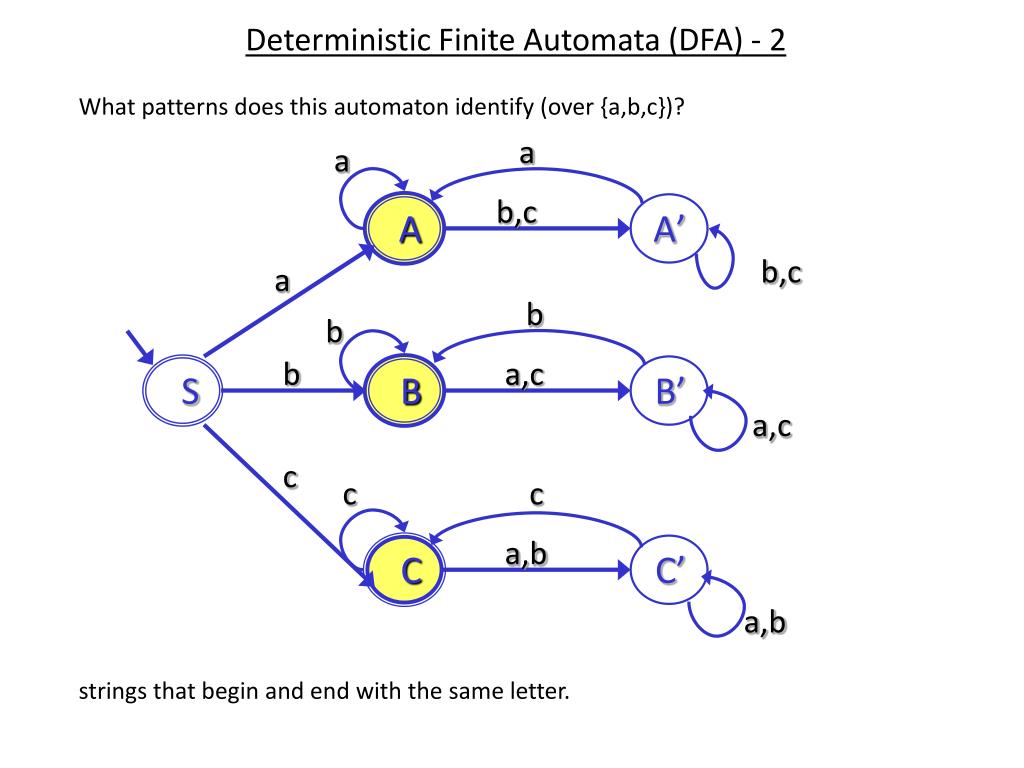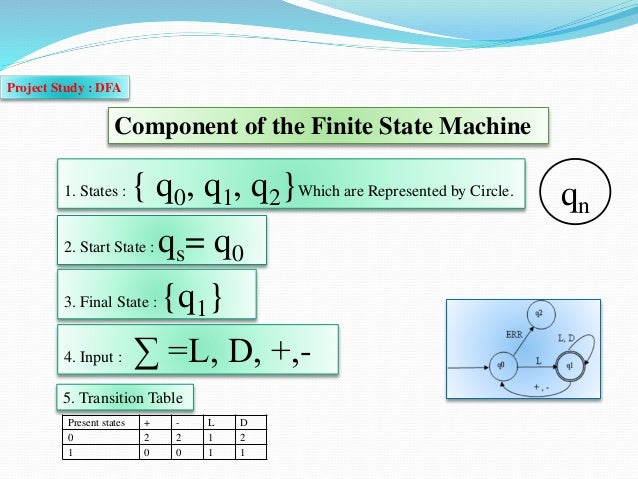
A transition table or a transition diagram usually represents the transition function. It is the core component of a DFA, and its definition is critical to the accuracy of the DFA. Transition Function: The transition function is a function that maps the current state and input symbol to the next state.In a DFA, input symbols drive the transition from one state to another. They are usually defined as part of the problem statement, and their number is finite.

Input Symbols : Input symbols are the characters or symbols the DFA accepts as input.The number of states in a DFA is determined by the complexity of the problem it is designed to solve. In a DFA, forms are finite and are characterized by unique identifiers, such as integers or letters. States : A state in a DFA represents the machine's current condition.Understanding these components is critical to constructing a DFA accurately. Understanding the Components of a DFAĪ Deterministic Finite Automata (DFA) is composed of five components: states, input symbols, transition function, start state, and accept conditions. These challenges, such as overlapping states, inconsistent transition functions, and improper definitions of accept states, can lead to a DFA that does not accurately reflect the behavior of the finite state machine. The article will also address some common challenges faced when constructing a DFA. It will then explain the steps for constructing a DFA, from determining the requirements to identifying the accepted states. The article will start by introducing the essential components of a DFA, such as states, input symbols, transition functions, start states, and accept conditions. This article is to provide a comprehensive guide on constructing a DFA. Moreover, they provide a simple yet powerful framework for understanding the behavior of finite-state machines. These are used to design algorithms and solve complex computational problems, such as recognizing common languages and the equivalence of finite automata. The significance of DFAs in computer science cannot be overstated. Additionally, these are used to implement regular expressions and patterns used to match characters in strings.
#CONSTRUCT A DETERMINISTIC FINITE AUTOMATON SOFTWARE#
DFAs validate inputs like email addresses, IP addresses, and URLs in software development. The primary purpose of a DFA is to recognize strings, sequences, or wording that belong to a particular set.ĭFAs are widely used in various applications such as lexical analysis, pattern recognition, and parsing of programming languages. It is fundamental of formal languages, automata theory, and computational theory.

Here q f is a final state, so we make q 1 also a final state.Deterministic Finite Automata (DFA) is a mathematical model used in computer science to describe the behavior of finite state machines. Here q 1 is an initial state, so we make q f also an initial state. Now we will Copy all these edges from q 1 without changing the edges from q f and get the following FA − Here the outgoing edges from q f is to q f for inputs 0 and 1. Here the ε transition is between q 1 and q 2, so let q 1 is X and q f is Y.

Δ − a transition function δ : Q × (∑ ∪ Removal of Null Moves from Finite Automata

This transition without input is called a null move.Īn NFA-ε is represented formally by a 5-tuple (Q, ∑, δ, q 0, F), consisting of Finite Automata with Null Moves (NFA-ε)Ī Finite Automaton with null moves (FA-ε) does transit not only after giving input from the alphabet set but also without any input symbol. If you want to convert it into a DFA, simply apply the method of converting NDFA to DFA discussed in Chapter 1. It is an NDFA corresponding to the RE − 1 (0 + 1)* 0. After we remove the ε transitions from the NDFA, we get the following − We will concatenate three expressions "1", "(0 + 1)*" and "0" Step 2 Remove Null transition from the NFA and convert it into its equivalent DFA.Ĭonvert the following RA into its equivalent DFA − 1 (0 + 1)* 0 Step 1 Construct an NFA with Null moves from the given regular expression. Some basic RA expressions are the following −Ĭase 1 − For a regular expression ‘a’, we can construct the following FA −Ĭase 2 − For a regular expression ‘ab’, we can construct the following FA −Ĭase 3 − For a regular expression (a+b), we can construct the following FA −Ĭase 4 − For a regular expression (a+b)*, we can construct the following FA − Method We will reduce the regular expression into smallest regular expressions and converting these to NFA and finally to DFA. We can use Thompson's Construction to find out a Finite Automaton from a Regular Expression.


 0 kommentar(er)
0 kommentar(er)
